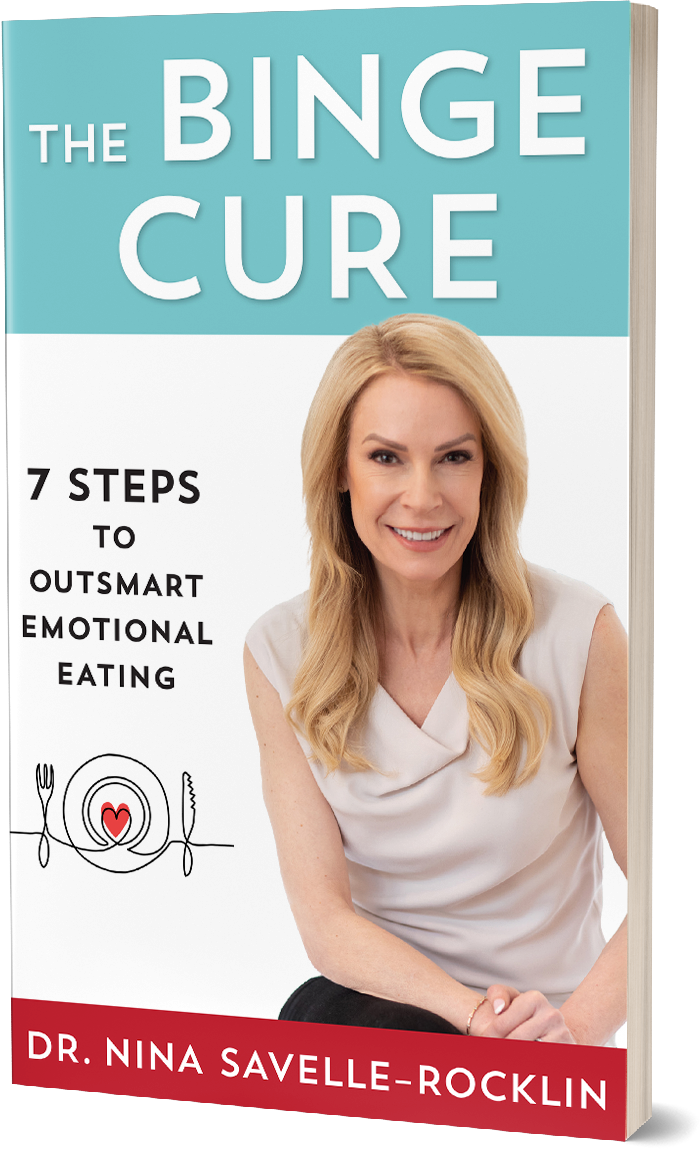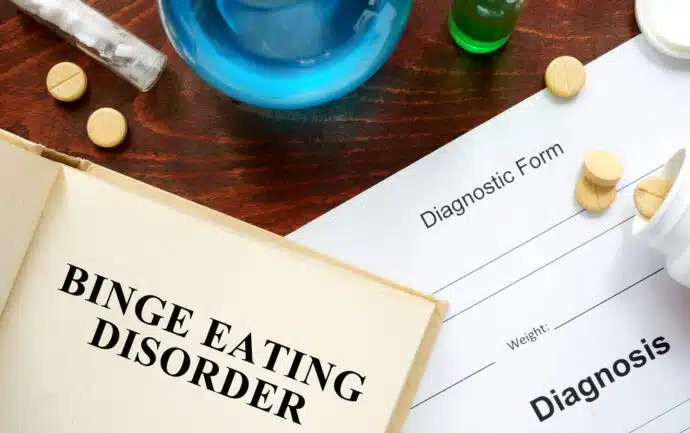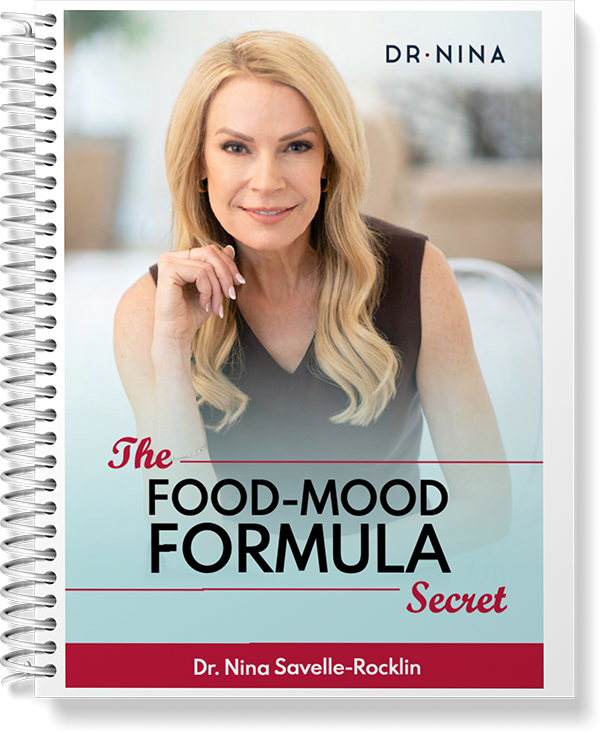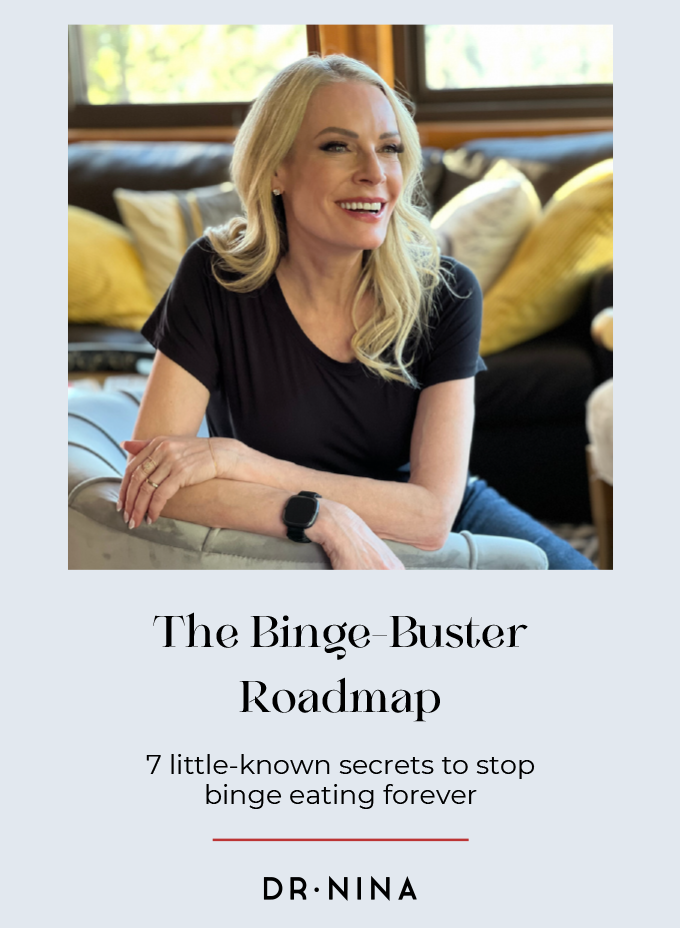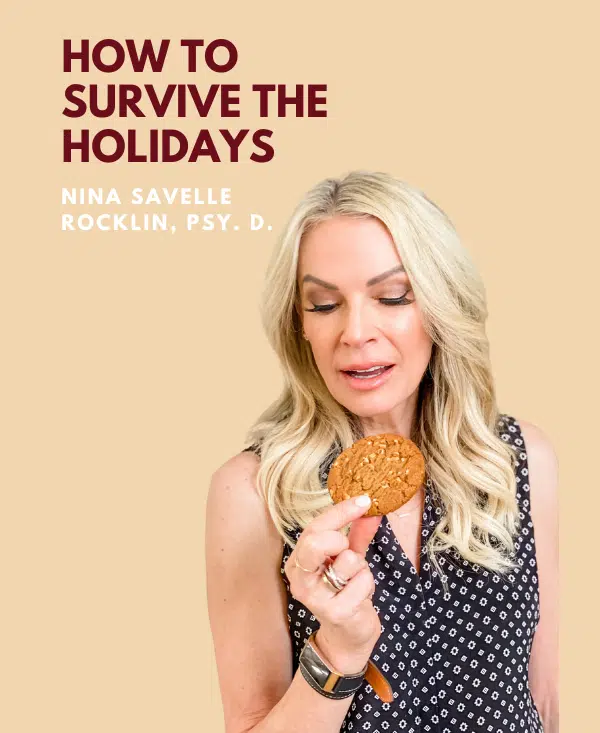Dr. Nina Savelle-Rocklin
10 Expert-Approved Tips to Battle Binge Eating
Table of Contents
- Stop Dieting
- What’s Eating “at” You?
- Do Some Ghostbusting
- Free Association
- Are You A Mind Reader?
- Don’t Turn on Yourself
- Identify Hidden Motivations
- Express Your Emotions
- Turn Your Inner Critic Into a Friend
- Frequently asked questions:
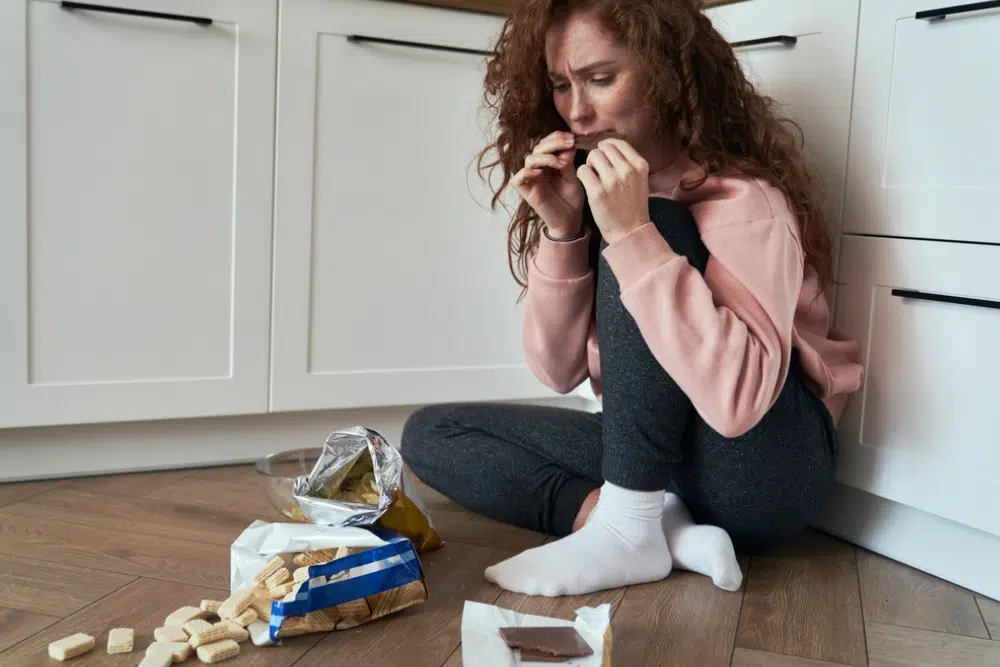
When most people want to stop binge eating, many of them do the wrong thing: they focus on willpower. Yet, binge eating disorder is not about willpower or control. It’s not about addiction. And it’s not even about food.
There are two main reasons for binge eating: one is the deprivation or the anticipation of deprivation of our favorite foods, and the second involves using food to cope with difficult thoughts and emotions.
To stop binge eating, it’s important to eliminate deprivation and understand that binge eating episodes are often triggered by emotional distress, such as sadness, anxiety, boredom, or stress. Food becomes a way to cope with these emotions, providing temporary comfort or distraction. However, after the binge, people feel intense feelings of guilt, shame, and self-disgust.
These emotions can be unconscious or hidden from our awareness. When we delve deep into the emotions and unresolved issues that are driving the binge eating behavior, we learn how to stop binge eating. Understanding these internal roots is essential for lasting change. Here are ten tips to stop binge eating disorder for good:
Stop Dieting
Do you feel like you’re always on a diet? Are you constantly worrying about what you’re eating, when you’re eating, and how much you’re eating? If the answer is yes, then it’s time to face a difficult truth: dieting is counterproductive to battling binge eating. In fact, it can actually lead to bingeing and to the binge-diet cycle.
The experience of deprivation or the anticipation of deprivation can be an incredibly powerful trigger for binge eating. If we’re constantly telling ourselves that we can’t have certain foods or if we have to limit our caloric intake excessively, we automatically set ourselves up for failure. Our minds rebel against the idea of restriction, and this often leads to overeating or, worse, binge eating.
Am I suggesting you indulge in unhealthy eating and forget about maintaining a healthy weight? Absolutely not. The key here is moderation, not elimination. It’s basic human psychology – the moment we know we’re not supposed to have something, we want it even more. Can you relate?
The healthier approach is to stop dieting and give yourself permission to eat your so-called forbidden foods. When you do that, you give yourself the gift of choice. You can choose if you want something, and if you have it, how much to have it. Research has shown that taking away deprivation can be an effective strategy in helping people stop binge eating.
One study found that people who were allowed to eat a variety of foods without any restrictions or deprivation experienced a significant reduction in binge eating episodes. This suggests that when people feel deprived of certain foods or food groups, they are more likely to engage in binge eating behaviors as a way to compensate for the perceived restriction. By removing the sense of deprivation, they are less inclined to engage in binge eating.
Furthermore, multiple studies have found that restrictive dieting and deprivation strongly predict binge eating. This further supports the idea that taking away deprivation can be beneficial in helping people stop binge eating.
What’s Eating “at” You?
This could be the most potent question you ever ask yourself. If binge eating is an emotional response, what’s the trauma or stress that’s triggering that response? Can you name it?
Identifying the emotional triggers behind your binge eating can be a daunting yet necessary step in overcoming this disorder. Many times, we eat not because we’re physically hungry but because we’re emotionally starved or stressed. Unresolved issues, stress, anxiety, and loneliness can lead to emotional eating.
So, what’s the solution? Listening to your emotions without judgment, analyze them, and seek healthier ways to manage them. This is where professional help can be invaluable. Therapists can guide you through the process of understanding your emotional responses and give you the tools to cope with them more effectively.
Battling binge eating is not just about controlling your food intake but also understanding why you’re overeating. It’s about digging deeper beneath the surface, navigating those uncharted emotional terrains, and garnering strength to bring about meaningful changes in your eating behaviors. Remember, the journey may be long, but it’s worth it.
Crack the Code of Emotional Eating
Take a moment to reflect on your most recent craving.
Were you yearning for something smooth and creamy, like ice cream or yogurt? Perhaps a smoothie crossed your mind. Or did you find yourself craving food that’s hearty and filling—bread, burgers, cake, pasta, or pizza? On the other hand, maybe it was all about that satisfying crunch—chips, pretzels, or crackers.
Now, what does all of this really mean?
In my two decades as a psychoanalyst treating people struggling with eating disorders, I discovered that our cravings often fall into three fundamental categories when we’re feeling upset:
Creamy…
Filling…
Crunchy…
When we crave ice cream or creamy treats, it’s not the ice cream itself we’re truly after—it’s comfort. The key to change lies in discovering new ways to comfort ourselves that don’t involve turning to food.
The second category, filling foods that occupy space, often symbolizes filling an emotional void. Instead, let’s take a closer look at the holes in our lives and find new ways to fill those empty spaces.
Last, crunchy textures—the ones that make us bite down hard—are often linked to forms of anger, like frustration, annoyance, irritation, or even rage. Instead, let’s learn to express anger in a healthier way—through words.
Now, what about chocolate? Where does it fit into this equation?
Some prefer milk chocolate or chocolate with creamy centers, while others won’t touch chocolate without nuts. Plain dark chocolate typically offers a bit of a satisfying crunch. So, when it comes to chocolate, it can either fall into the creamy category, associated with comfort, or the crunchy category, tied to various forms of anger.
Perhaps what we truly need is more sweetness in our lives. Not the kind that comes from sugar but the sweetness of connection, fulfillment, and love.
This is what I call my Food-Mood Formula. Remember that enjoying some chips alongside your sandwich differs significantly from devouring a family-sized bag of Doritos while battling self-loathing with each bite. The Food-Mood Formula comes into play when you feel that tug toward food to alter your emotional state.
The next time you feel a craving, pause and consider whether it falls into the creamy, filling, or crunchy category. By recognizing and responding to these underlying needs, emotions, desires, and conflicts, you can break the cycle of eating to cope.
What I’ve just shared is a valuable tool that enables you to uncover your concealed “WHY.” This way, you can shift your focus from what’s eating “at” you to what you’re truly eating for.
Do Some Ghostbusting
We often think that the past is over, but often, dynamics and relationships from the past are actually haunting our present. Uncovering early childhood experiences or relationships that contribute to emotional eating patterns can be illuminating.
One way to identify these patterns is by reflecting on your early memories and experiences. Think back to your childhood and try to recall any significant events or situations that may have influenced your relationship with food. For example, were there any instances where you felt restricted or deprived of certain foods? Did you experience any emotional or psychological trauma that may have led to using food as a coping mechanism? By exploring these memories, you can gain insight into the origins of your binge eating behavior.
Another way to identify patterns is by considering your family dynamics and upbringing. Consider the role that food played in your family when you were growing up. Did your parents or caregivers have their own struggles with food or body image? Were there any specific food-related rules or behaviors in your household? Understanding the influence of your family environment can provide valuable clues about the development of your binge eating patterns.
Getting professional help from a therapist specializing in binge eating disorder therapy can assist in identifying early childhood patterns. Professionals are trained in binge eating disorder treatment to help you explore your past and recognize the link to your relationship with yourself and food. You can gain a deeper understanding of patterns and dynamics from the past and how they continue to impact your relationship with food. A therapist provides guidance and support as you work towards changing these patterns and developing healthier coping mechanisms.
When we banish the ghosts of the past, we’re liberated in the present.
Free Association
Free association is based on the belief that our unconscious holds important information and influences our thoughts, feelings, and behaviors. This method means allowing your mind to wander freely and express thoughts, feelings, and memories without censorship. This is a way to uncover hidden triggers that may be contributing to binge eating episodes.
For example, someone might associate the smell of freshly baked cookies with feelings of comfort and security, which could trigger a binge eating episode when they want to self-soothe. By exploring these associations, you get insight into the underlying triggers and can work towards developing healthier coping mechanisms.
Another way of freely associating is journaling. By allowing thoughts to flow freely, you may uncover triggers that you were not consciously aware of. For instance, you may realize that certain emotions, such as stress or loneliness, consistently precede their binge eating episodes. Identifying these triggers can be a crucial step towards developing strategies to manage and prevent binge eating.
A benefit of free association is exploring the connections between past experiences and present triggers. Binge eating behaviors can be linked to unresolved emotional issues or traumatic events from the past. Someone might realize that binge eating episodes are triggered by feelings of abandonment, which stem from a childhood experience of abandonment or rejection. Understanding these issues can help you address the root causes of binge eating so you can work towards healing and create change.
Imagine Maya, who began discussing her frustration with herself for bingeing after she was passed over for a promotion at work. Then, she associated to a childhood memory of being overlooked in favor of her younger sister during a family celebration. She recalled the feelings of inadequacy and how she would secretly eat cookies afterward.
These associations of ideas make it clear that when Maya didn’t get the promotion, she felt as inadequate and rejected as she had as a child. Binge eating temporarily soothed her and kept the painful memories from her past out of her awareness. When we healed the past, Maya was less impacted by situations like this in the present.
Are You A Mind Reader?
Mind reading involves making assumptions about what you are thinking or feeling without any actual evidence. This can create a sense of insecurity and anxiety, which may trigger the urge to cope with these emotions through food. For example, if someone believes others are judging them for their appearance or eating habits, they may binge as a way to cope, temporarily escaping painful thoughts and emotions.
When we think we know what other people are thinking, we often imagine they think the same thoughts about us as we think. If we are self-critical, we assume others are criticizing us. This can create feelings of shame, guilt, and low self-esteem, which is relieved (albeit temporarily) through binge eating.
Mind reading leads to feelings of anxiety, self-consciousness, and isolation. If you believe people are judging you, you’ll avoid them or feel terrible and self-soothe with food. After all, people can be unreliable, unavailable, and unpredictable, but food is reliable, available, and predictable.
To create change, it is important to first become aware of when you are engaging in mind reading. Pay attention to the thoughts and assumptions that arise in your mind during social interactions or when interpreting others’ behaviors.
Once you have identified instances of mind reading, challenge whether the thoughts you believe other people are thinking mirror your self-concept. If so, identify and challenge the negative beliefs you have about yourself. You learned this way of relating to yourself and others. You can unlearn it and create a new dynamic.
Don’t Turn on Yourself
We live in a culture that frowns on emotions, especially anger. When anger is not identified and processed, it’s often turned inward. Instead of expressing frustration, irritation, anger, or rage, people attack themselves for what they’re eating or what they weigh.
This can often be a gender issue. Expressing anger has historically been seen as unfeminine and socially unacceptable. This has led to women suppressing their anger but then turning it against themselves. Many women feel guilty about feeling mad, so they turn against themselves.
Imagine Brianne, who had a particularly challenging day at work and felt a growing sense of irritation and anger. Instead of addressing these emotions directly or finding a healthy outlet for them, she turned to food. Brianne started eating a large bag of potato chips, consuming them quickly and without enjoyment.
As she finished the chips, a wave of guilt washed over her. She berated herself for giving in to what she views as a “weakness.” Rather than expressing her frustration or acknowledging the source of her anger, she directed all of her negative feelings inward, attacking herself for her eating choices.
Instead of processing and dealing with her emotions, Brianne ate chips and then took her anger at the work situation out on herself. Turning on the self is self-directed hostility that can manifest in various ways, such as self-criticism, self-blame, self-harm, or self-sabotage.
Another example of turning against the self is when someone constantly berates themselves for making a mistake, even if it was a minor one. They engage in negative self-talk, calling themselves names or belittling their abilities. This perpetuates feelings of low self-worth and contributes to binge eating as a way to cope.
Identify Hidden Motivations
Binge eating can often be driven by unconscious reasons, such as symbolically filling a void, converting emotional pain to physical pain, and displacement. Filling a void means turning to food as a way to compensate for some emotional or psychological emptiness. Consuming large quantities of food can temporarily provide a sense of fullness, which can serve as a substitute for other unmet needs or desires. By identifying and filling the holes in your life, you have a sense of fulfillment and stop using food to fill the emptiness.
Another hidden reason behind binge eating is turning emotional pain into physical pain. It’s easier to feel physical pain than it is to deal with emotional pain. By turning heartaches into stomachaches, we temporarily escape what’s hurting us on an emotional level.
Displacement is another hidden motivation. Imagine Alex, who vehemently expressed self-loathing every time he binged on food. He mentioned a recent argument with his wife and said he felt stifled and unheard, but he was more angry with himself for bingeing. Alex’s anger towards himself for binge eating was actually a displacement of the anger and frustration he felt towards his wife but couldn’t express.
Alex was using food as an outlet for the emotions he couldn’t confront directly. By recognizing this pattern, Alex started addressing his communication issues with his wife and ultimately stopped binge eating.
Express Your Emotions
We cannot ignore our emotions. We can’t drop them or positive-think them away, and we certainly can’t stuff them down. Nor can we “sit” through our feelings until they’re gone. Since we live in a culture that says we’re weak if we have emotions and strong if we suppress them, many of us don’t know how to feel feelings.
Take the time to identify what you are feeling and give yourself permission to experience those emotions fully. Hint: if you don’t know what you’re feeling, use the Food Mood Formula as a guide. Once you have recognized your feelings, it can be helpful to express them in a healthy way.
This might involve talking to a trusted friend or family member, writing in a journal, or engaging in creative outlets such as painting or playing music. By expressing your feelings, you allow yourself to release pent-up emotions and gain a better understanding of what you are experiencing.
Turn Your Inner Critic Into a Friend
Turning your inner critic into a friend can be a transformative process that involves self-reflection and self-compassion. Here are some steps you can take to achieve this:
1. Recognize the purpose of your inner critic: Your inner critic often emerges as a defense mechanism to protect you from potential harm or failure. Understanding that its intention is to keep you safe can help you approach it with empathy.
2. Challenge negative self-talk: Start by becoming aware of the negative thoughts and beliefs that your inner critic generates. When you catch yourself engaging in self-critical thinking, challenge those thoughts by asking yourself if they are based on evidence or if there are alternative perspectives.
3. Practice self-compassion: Treat yourself with kindness and understanding, just as you would a close friend. When your inner critic arises, counteract its negativity by reminding yourself of your strengths, accomplishments, and positive qualities.
4. Cultivate self-acceptance: Embrace your imperfections and recognize that nobody is perfect. Understand that making mistakes is a natural part of growth and learning. Instead of berating yourself for your flaws, focus on self-improvement and personal growth.
5. Reframe failures as opportunities: Instead of viewing failures as reflections of your worth or abilities, see them as opportunities for growth and learning. Embrace the lessons that can be derived from setbacks and use them to propel yourself forward.
By creating a different relationship with yourself, you’re less likely to eat to escape your own mean voice. Turning an inner critic into a friend alleviates binge eating by shifting the focus from self-judgment to self-compassion, challenging negative thoughts and beliefs, and fostering self-acceptance. By cultivating a friendly inner voice, you can develop a healthier and more positive relationship with yourself and give yourself the reassurance and support that leads to lasting change.
It is important to note that no one tip is a standalone solution for overcoming binge eating disorder. Each of these suggestions is just one tool in a comprehensive treatment approach. Seeking professional help from a therapist who specializes in binge eating disorder therapy is crucial for developing a personalized treatment plan.
Binge eating recovery is possible. Depth psychology provides guidance and support in exploring triggers, understanding their origins, and developing healthier coping mechanisms. By identifying the roots of the behavior, expressing yourself, and cultivating new ways of responding to yourself, everything with food can change forever. It is possible to go beyond recovery to liberation from binge eating. When that happens, binge eating is something you used to do that is now in your rearview mirror. There is hope.
Frequently asked questions:
What are the main reasons for binge eating?
The two primary reasons for binge eating are the anticipation or experience of deprivation of favorite foods and using food to cope with difficult thoughts and emotions, such as sadness, stress, or anxiety.
How is dieting related to binge eating?
Dieting can be counterproductive to combating binge eating. The feeling or anticipation of deprivation from dieting can be a powerful trigger for binge eating. Instead of strict dieting, it’s healthier to approach food with moderation and allow oneself the choice to enjoy various foods.
Why do people often resort to binge eating when emotionally distressed?
Many people use food as a way to cope with emotions, seeking temporary comfort or distraction. Binge eating can be a response to feelings like sadness, anxiety, or boredom. However, post-binge, individuals often feel guilt, shame, and self-disgust.
How can understanding cravings help combat binge eating?
Cravings, like those for creamy, filling, or crunchy foods, often have emotional triggers. Recognizing and responding to the underlying emotional needs can help break the cycle of eating to cope.
What role do past experiences play in current binge eating behavior?
Past dynamics and relationships, particularly from early childhood, can influence present-day emotional eating patterns. Exploring these past memories and influences can provide insight into current behaviors and help in addressing the root causes of binge eating.
How can one turn their inner critic into an ally in the battle against binge eating?
Transforming your inner critic involves understanding its protective intentions, challenging negative self-talk, practicing self-compassion, and cultivating self-acceptance. By nurturing a positive inner voice, you can foster a healthier relationship with yourself and make lasting changes in your eating behaviors.
Ready to transform your relationship with food?
Join Dr. Nina's newsletter and receive:
• Expert tips on overcoming emotional eating
• Strategies for sustainable weight loss
• Exclusive content not found anywhere else
Don't miss out on the latest breakthroughs in binge eating!
The Author

Dr. Nina Savelle-Rocklin is a renowned author and podcast host and one of the nation’s leading psychoanalysts known for the psychology of eating. Her signature message of, “It’s not what you’re eating, it’s what’s eating ‘at’ you” has resonated with hundreds of thousands of listeners from around the globe in 40 countries. As founder of The Binge Cure Method, she guides emotional eaters to create lasting food freedom so they can take back control of their lives and feel good in their bodies.
Related Blogs

